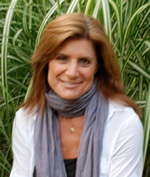Wedding bells are ringing in June, and some Chicago couples are adding green elements to their celebrations with the help of a group that connects vendors to eco-conscious consumers.
The Chicago Green Wedding Alliance has nearly tripled in size in its two years as more small-business owners are offering sustainable features for couples planning weddings, commitment ceremonies and other life events that are mindful of their impact on the planet and their communities.
The alliance was formed to encourage more people to consider adding an eco-minded aspect to their weddings, according to Lynn Fosbender, one of the co-founders and owner of Pollen Floral Design, a floral design studio that specializes in green weddings and other gatherings. The other co-founders are Amanda Eich and Tony Vassallo, who own Spilled Ink Press, a firm that uses recycled paper and other sustainable materials in its invitations and other custom-printed paper goods.
An initial collection of a dozen local companies got the nonprofit off the ground in 2010. The community of vendors within the alliance has grown to more than 30 this year, including caterers that source organic and sustainable food from local farmers, such as FIG Catering and City Provisions, and green event spaces such as Catalyst Ranch and Greenhouse Loft.
Crain’s met Ms. Fosbender between flower runs this week to learn more about the alliance’s activities in growing this sector of the local green economy.
Crain’s: Why was there a need to form the Chicago Green Wedding Alliance?
Ms. Fosbender: I’m doing something a little unusual trying to work with locally grown and sustainably grown flowers. I found myself working with a lot of the same green vendors and getting good referrals and I thought we could form a community if we could get all these like-minded people together. As a group, we might be able to encourage more eco-friendly weddings and events and make it easier for those couples to find us.
Crain’s: What are some of the most popular ways for couples to add sustainability to their big day?
Ms. Fosbender: Many couples aren’t making their weddings fully sustainable, but they’re choosing the things that are most important to their values. To some people it’s the food, to others it’s decor or the venue.
It seems like working with locally and sustainably grown food has really gotten some traction and is becoming more achievable as more vendors and caterers are offering it.
In the Midwest people are becoming more aware of the environmental impact that cut flowers have in the production process, transportation and the way workers are treated. It’s less intuitive than sustainable food, but similar to the impact it has on the environment. I’m also going to start offering living centerpieces. I’ll be partnering with Greenhouse Loft to rent out succulents for some events.
Some ways to add sustainability aren’t even about services. One idea is to choose a venue that will accommodate the ceremony and the reception. That cuts down on transportation for guests and vendors, which shrinks the carbon footprint of the event. I even offer a discount to people who do that because my staff doesn’t have to travel to two venues.
Crain’s: Are there any particular services that are hot right now or just coming up on the radar for wedding planning?
Ms. Fosbender: There’s a move toward working with local artisans for paper items, such as invitations and programs. They’re working with recycled paper and vegetable-based inks.
One of the easier things that some couples do to have the biggest impact is to decrease the guest list. It decreases the amount of food that’s needed, and the size of the space. It’s an easy and cost-effective way to be more green.
Crain’s: What has the alliance done to generate more buzz around the green wedding concept?
Ms. Fosbender: One of our first events was a workshop for event planners to understand how to help clients plan more eco-friendly weddings. That really helped us get the word out. This past February, we had a show and our vendors had tables out to show their wares to event planners and couples.
Crain’s: There’s a lot of new vendors listed with the alliance. What’s your vetting process to make sure they’re truly “green”?
Ms. Fosbender: We have an application process with a series of questions that ask about the operations of the business and we have vendor-specific categories that get into more details of how sustainable they are. We rely on the one-on-one meetings to see that they are indeed acting the way they say they are. We’ve denied applications before and we’ll suggest ways to get them up to our standards. We also want people to be actively involved in the education and marketing component of the group to spread the word (about greening an event).
Crain’s: Do you think entrepreneurs will find a growing market for green weddings if they decide to focus their energy in this area?
Ms. Fosbender: I don’t think this is just a fad. With each generation, there’s a greater understanding that we need all the resources we have and we need to nurture them. Those values are being passed along and encouraged. I think this is here to stay.


